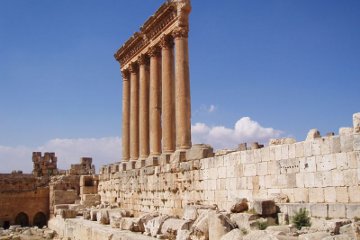Baalbek Barbarians
Baalbek, the spectacular ruins in the Beqaa Valley between the Lebanon and Anti-Lebanon mountains, was first excavated approximately a century ago after Kaiser Wilhelm II visited the site and was so impressed that he ordered German archaeologists to work there. The Germans did a lot of useful work, clearing and renovating the massive temples and making the site accessible to the general public.
Much of their work was undone, however, in the late 1970s and 1980s when Lebanon fell into civil war and Baalbek became a stronghold of the fanatical Hisbollah movement. The happy days that I well remember, when busloads of foreign tourists mingled with crowds of local Lebanese picnicing and dancing among the ruins, vanished overnight and dark rumours circulated of how the ancient stones were being vandalised by Kalashnikov-toting thugs in the name of Allah.
With the return of peace to the Lebanon the fanatics are gone and tourists are starting to percolate back to Baalbek. Archaeologist Helen Sader, of the American University of Beirut, in association with Camille Asmar, head of the directorate-general of antiquities, decided that the time had come to construct an on-site interpretative centre to enable tourists to get the most out of their visit to Baalbek.

| |
| The vaults beneath this temple are now protected by an acre of tarmac. |
The ideal place seemed to be in the huge vaults underneath the temple platform of the temple of Jupiter, most of which were being used as storeage space anyway; one even housed a diesel generator and the ancient stones were black with exhaust fumes. In order to protect the floor of the vaults, Sader and Asmar authorised the laying of a concrete walkway, but then they faced another problem.
Although the huge stones of the vaults admirably performed their function of holding up the temple overhead, they were not designed to be waterproof. The ancient architects never imagined that anyone would want to use this redundant space! Unfortunately modern display cases with sensitive (read "gloomy") lighting react badly to having rain water dripping down on them, so the next step taken by Sader and Co. was to pave the courtyard above - with ashphalt!
The pair claim to be both surprised and hurt by the uproar their action has aroused. They point out that they have carefully laid the cement on a thick layer of sand, lest the acids in the cement attack the limestone of the temple, and a similar layer of sand underlies the ashphalt in the temple courtyard. Somehow neither "expert" can see anything incongruous in the sight of the famous pillars of the Temple of Jupiter rising sheer out of acres of gleaming tarmac.
Diggings has a further suggestion: wait until the furore has died down, then paint white lines on the tarmac and turn the place into a giant parking lot. In addition, there is an awful lot of space going to waste in the nearby temple of Bacchus and with the use of several hundred tons of unobtrusive steel scaffolding - set, of course, on a thick layer of sand - the building could be turned into a tasteful, multi-level supermarket. The money thus raised could then be used for further "restoration": a big dipper swooping over the Temple of Venus, for example, or a ball-bearing factory in the temple courtyard. The opportunities for any entrepreneur with a barbarian turn of mind are endless.





